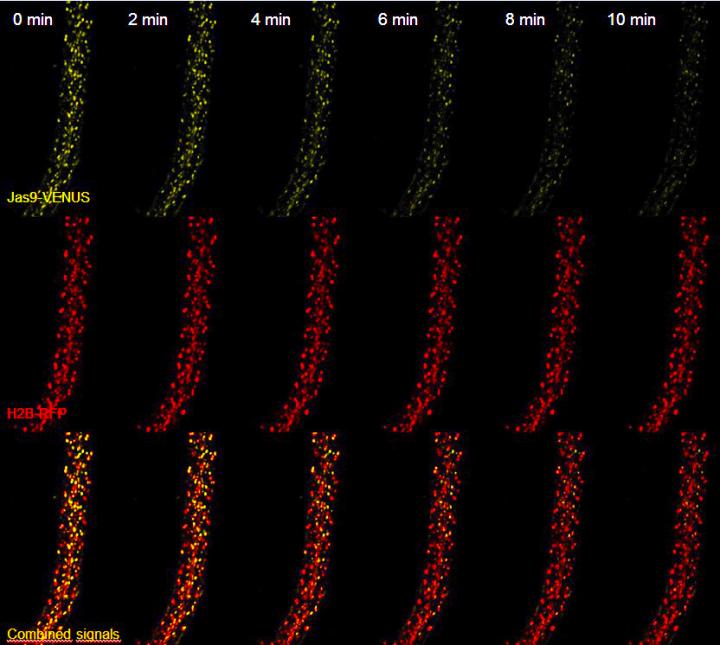Picture this — biosecurity seen from the inside

The Jas9-VENUS biosensor responds to changes in jasmonic acid levels. Credit: The Centre for Plant Integrative Biology
The research, “A fluorescent hormone biosensor reveals the dynamics of jasmonate signalling in plants”, was carried out by an interdisciplinary team from the UK, France and Switzerland and has been published in the leading academic journal Nature Communications.
Malcolm Bennett, Professor in Plant Science at The University of Nottingham and Director of the Centre for Plant Integrative Biology, said: “Understanding how plants respond to mechanical damage, such as insect attack, is important for developing crops which cope better under stress.”
Their research focussed on the plant hormone jasmonic acid which is part of the plant's alarm system and defence mechanism. Jasmonic acid is released during insect attack and controls the response to damage. Disease can also trigger jasmonic acid – so it's a general defence compound.
Professor Bennett said: “We have created a special fluorescent protein – Jas9-VENUS – that is rapidly degraded after jasmonic acid is produced. This allowed us to monitor where jasmonic levels are increased when the fluorescent signal is lost.”
Using a blade to damage a leaf the research team mimicked an insect feeding. With the fluorescent protein they were able to image how damage to a leaf quickly results in a pulse of jasmonic acid that reaches all the way down to the tip of the root, at a speed of more than a centimetre per minute. Once this hormone pulse reaches the root it triggers more jasmonic acid to be produced locally, amplifying the wounding signal and ensuring other parts of the plant are prepared for attack.
Professor Bennett said: “Jasmonic acid triggers the production of defence compounds like protease inhibitors to stop the insect being able to digest the plant proteins – the plant becomes indigestible and the insect stops eating it.”
Laurent Laplaze, a group leader at IRD (Institut de recherche pour le développement) in Montpellier, described the new biosensor used to pinpoint what happens when plants are damaged. He said: “The Jas9-VENUS biosensor responds to changes in jasmonic acid levels in plant cells within a few minutes. Our new biosensor now allows us to see exactly where jasmonic acid is being perceived by the plant, but in a quantifiable way.”
The new biosensor can be used to understand how the plant can coordinate a defence response. Teva Vernoux, a CNRS group leader at the Ecole Normale Supérieure in Lyon, said: “The amazing sensitivity of our new biosensor allows us to follow in real time how jasmonic acid levels are modified in a tissue when a mechanical damage occurs in another tissue some distance away. This really opens the possibility to understand changes in the physiology at the whole plant level upon stress or damage.”
This research was partly funded by the Biotechnology and Biological Sciences Research Council (BBSRC), the Agence Nationale de la Recherche (ANR), the Agropolis Fondation, and the Région Languedoc-Roussillon.
Media Contact
All latest news from the category: Interdisciplinary Research
News and developments from the field of interdisciplinary research.
Among other topics, you can find stimulating reports and articles related to microsystems, emotions research, futures research and stratospheric research.
Newest articles

A universal framework for spatial biology
SpatialData is a freely accessible tool to unify and integrate data from different omics technologies accounting for spatial information, which can provide holistic insights into health and disease. Biological processes…

How complex biological processes arise
A $20 million grant from the U.S. National Science Foundation (NSF) will support the establishment and operation of the National Synthesis Center for Emergence in the Molecular and Cellular Sciences (NCEMS) at…

Airborne single-photon lidar system achieves high-resolution 3D imaging
Compact, low-power system opens doors for photon-efficient drone and satellite-based environmental monitoring and mapping. Researchers have developed a compact and lightweight single-photon airborne lidar system that can acquire high-resolution 3D…





















